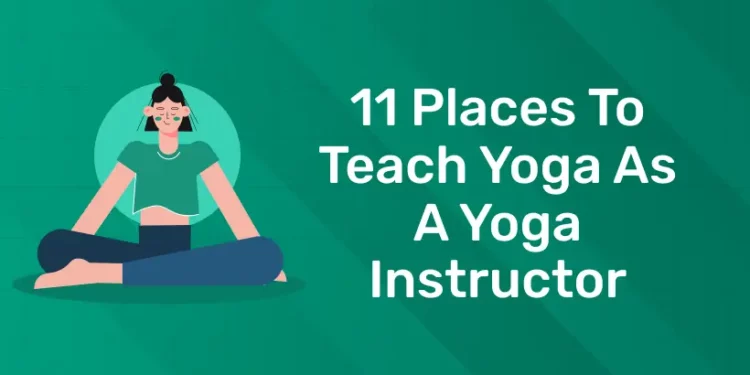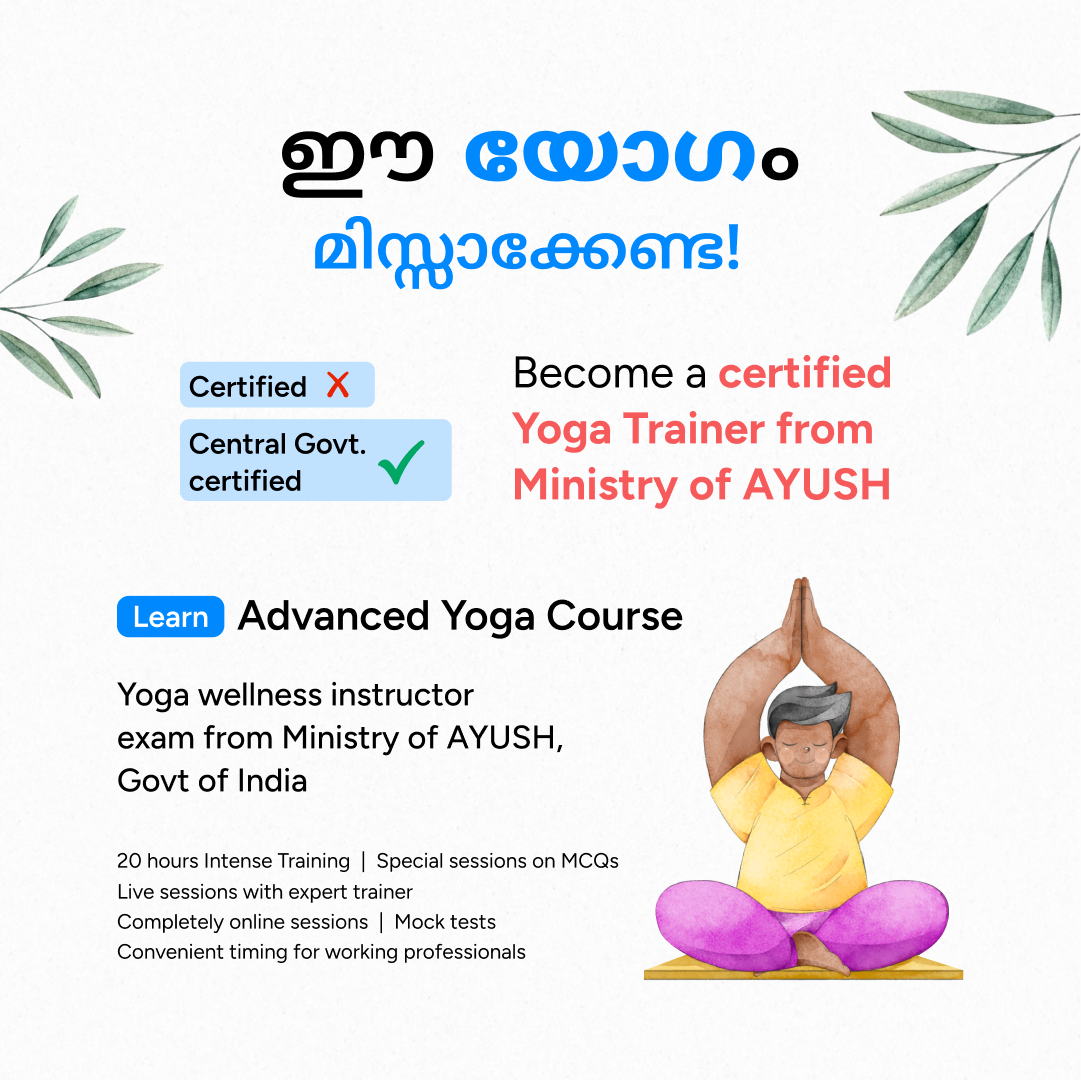Table of Contents
Whether you have recently graduated from yoga instructor training or you are an experienced yoga instructor, figuring out how to take your skills and offerings to the next level can be daunting. There are a lot of options and methods for teaching yoga. Let’s review the benefits and drawbacks of the various yoga teaching options that are accessible to you today so that you can be ready to make the most of them. Find your yoga niche, by thinking beyond the studio and begin planning to build your classes and yoga career.
If you’re like many new yoga instructor, you decided to teach yoga because you love the practice and want to share it with others. However, you may finish a yoga instructor training having an in-depth knowledge of teaching but very little knowledge about where to begin to build your yoga business.
Get Certified, Get Confident! Join Our Yoga Teacher Training Course!
Places to Teach Yoga as a Yoga Instructor
I suggest that anyone looking for a teaching job stay away from the newest, trendiest, and occasionally even the most reputable yoga studios. Rather, I suggest going to unusual places where you can both spread the word about yoga and get useful experience. This holds true for anybody hoping to broaden the scope of their teaching, not simply aspiring yoga instructors.
Obtaining experience in teaching can be accomplished in a variety of ways. What if we could devote the majority of our time to acquiring hands-on experience and spreading this game-changing method to an increasing number of people in the real world? While it might not be glamorous, it is undoubtedly rewarding. Additionally, it gives us something very important—the real-world experience we require to become proficient teachers. Some of the locations you can visit are listed below.
1.Yoga Studios – The Heart of Yoga Communities
- Introduction to yoga studios as dedicated spaces for yoga practice and instruction.
- The serene and focused environment of yoga studios conducive to teaching various yoga styles and levels.
- The sense of community and connection fostered within yoga studios, making them ideal places for instructors to share their passion for yoga.
- Yoga studios, which are generally thought to be the hardest places for new instructors to get hired, might be more likely to hire you if you’re willing to teach at odd hours like 6 a.m. or 8 p.m. Or if you’ve developed a niche market niche like yoga for stiff white guys or teens.
- Don’t undervalue the importance of substitute teaching, either. Often, the easiest approach to get into a studio is to establish yourself as a reliable substitute.
- Make inquiries about being included to sub lists at other studios, or inquire with a buddy who is currently teaching if you may cover for him.
2.Fitness Centers and Gyms – Reaching a Broader Audience
- The integration of yoga classes into fitness centers and gyms to cater to members’ holistic wellness needs.
- The opportunity for yoga instructors to reach a broader audience and introduce yoga to individuals new to the practice.
- The diverse range of yoga styles and class formats offered in fitness centers and gyms, catering to different fitness levels and preferences.
- Of course, gyms are more focused on fitness than your average yoga studio. However, because yoga is such an excellent discipline for increasing general wellbeing, lowering stress levels, and improving strength and flexibility, it is offered in many areas.
Like a community centre, an exercise centre may be noisy, have strong lighting, and have mirror walls—not the best places to gaze.
If you teach at a gym, though, there’s a decent likelihood that students will show up for your lessons. Since each student will have a unique body type and level of yoga expertise, teaching students will also provide you with valuable experience. - If you are a multidisciplinary instructor with such talents, you may also be able to teach dance, pilates, or other movement-based activities.
3.Community Centers – Serving Local Communities
- The role of community centers in providing affordable and accessible yoga classes to local communities.
- Teaching yoga at community centers as a way to engage with diverse groups of people and contribute to community well-being.
- The potential for collaboration with community organizations to offer specialized yoga programs for underserved populations.
- Due to the widespread acceptance of yoga, memberships at local Ys, libraries, civic centres, parks, and leisure centres, as well as the general public, frequently offer lessons to its members.
- It was during those years that I was devoted to my workshops at the Y that I learned how to instruct those who were completely new to the practice. It also made it possible for me to develop a loyal student body.
4.Corporate Offices – Promoting Employee Wellness
- The growing demand for corporate yoga programs as employers recognize the benefits of yoga in reducing stress and improving employee well-being.
- Teaching yoga at corporate offices or offering workplace wellness programs as a way to bring yoga directly to professionals in their workplace environment.
- The opportunity for yoga instructors to customize classes to address common workplace issues such as stress, fatigue, and poor posture.
- Many people nowadays wish they could include yoga in their daily practice, but they are too busy. Many businesses provide wellness events, such as yoga courses, to their staff members directly in an effort to address this demand.
- Many urban apartment buildings are doing the same thing, saving occupants from ever having to leave the building.
- Jessica Kang taught overseas for three years following her YTT. She approached a high-rise apartment building and inquired about the possibility of offering yoga to the tenants. They acknowledged. Since then, she has established Yogis On The Move, a business that offers yoga and other wellness and exercise programmes to over 40 Southern California apartment buildings.
Get Certified, Get Confident! Join Our Yoga Teacher Training Course!
5.Schools and Universities – Fostering Healthy Habits
- The inclusion of yoga classes in school and university wellness programs to promote physical fitness and mental well-being among students.
- Teaching yoga at schools and universities as a way to introduce yoga to students of all ages and encourage healthy habits early in life.
- The potential for collaboration with educators and administrators to integrate yoga into the curriculum and create a culture of mindfulness and self-care on campus.
- Teaching yoga to those who might need some help centering and calming themselves is another method to share yoga with children (and their teachers!).
- Once more, specific training might be needed for this, however there are plenty of kids yoga teacher training programmes available.
- If you are a parent, you could inquire about the possibility of yoga being offered to the kids (or the adults!) in your child’s preschool, grade school, junior high, or even high school. In my early years, I worked as a teacher at a nearby charter high school, and I had a great time there.
- Teens often had trouble focusing, but they added a lot of energy and lighthearted humour to the classroom, in my experience.
6.Retreat Centers – Immersive Yoga Experiences
- The allure of retreat centers as idyllic settings for immersive yoga experiences and personal transformation.
- Teaching yoga at retreat centers as an opportunity to lead intensive workshops, retreats, and yoga instructor training programs while surrounded by nature and like-minded individuals.
- The potential for instructors to deepen their own practice and connect with students on a deeper level in the serene and supportive environment of retreat centers.
7.Wellness Resorts and Spas – Integrating Yoga into Holistic Wellness Offerings
- The role of wellness resorts and spas in offering yoga classes as part of their holistic wellness offerings.
- Teaching yoga at wellness resorts and spas as a way to provide personalized instruction and cater to individuals seeking relaxation, rejuvenation, and self-care.
- The opportunity for yoga instructors to collaborate with wellness professionals and offer integrated wellness programs combining yoga, meditation, massage, and other healing modalities.
- In order to help people meet many of their wellness needs in one place, some acupuncture clinics, Ayurvedic centres, massage studios, mental health counselling offices, and therapy groups also offer yoga lessons.
- If you are interested in working one-on-one with people, this could also be an opportunity to develop a private teaching practice.
8.Online Platforms – Reaching a Global Audience
- The popularity of virtual teaching platforms and online yoga courses as a means for yoga instructors to reach a worldwide audience.
- Online yoga education offers students flexibility and convenience through live-streamed courses, pre-recorded videos, and personalised instruction.
- The opportunity for educators to use online teaching platforms to broaden their audience, develop a personal brand, and make passive revenue.
9.Outdoor Spaces – Connecting with Nature
- The rejuvenating experience of teaching yoga in outdoor settings such as parks, beaches, and gardens.
- The opportunity to connect with nature and create a sense of grounding and connection in outdoor yoga classes.
- Teaching yoga in outdoor spaces as a way to inspire mindfulness, gratitude, and reverence for the natural world.
- Start teaching weekly Ashtanga courses at a nearby park to my friends shortly after YTT. Since they provided with an opportunity to practise teaching in a low-pressure environment and made them donation-based.
- Also learn about the requirements for managing a firm. For instance, they discovered that, regardless of class size, it was crucial to send out weekly reminders and to constantly show up.
- Make sure you have the necessary permits before teaching in any public outdoor area, such as a park or beach. You may choose to go the easier path and instruct in your backyard or the backyard of a friend or relative if the permit application process is costly or time-consuming.
- People who want to practise yoga are frequently in our lives; all they need is a time and location to show up with a trusted partner.
10.Specialized Populations – Tailoring Yoga for Specific Needs
- The importance of specialized training and knowledge in teaching yoga to specialized populations such as seniors, children, pregnant women, individuals with disabilities, and athletes.
- The opportunity to make yoga accessible to everyone by adapting the practice to meet the unique needs and abilities of each group.
- The potential for yoga instructor to make a meaningful difference in the lives of specialized populations by providing compassionate and inclusive yoga instruction.
11.Vulnerable Populations
- If you are called to teach yoga to people who might benefit from it but are unable to go to sessions, you might want to think about setting up a treatment centre, hospital, prison, or elder care facility.
- Spending a few years at a facility that helps women overcome eating problems and continue to have a relationship with one of the patients. That instance demonstrated the particular difficulties involved in teaching yoga to disadvantaged groups of people.
- These children might need to move very slowly or avoid certain movements entirely due to a history of trauma or physical issues. When necessary, it’s critical to acquire specialised training, and you should always collaborate with the staff to make sure you’re addressing the demands of the students.
- The fundamental basis of a yoga session in non-traditional settings, such as schools, jails, and rehabilitation centres, is relational: as a group, we are developing a sense of safety, strength, gentleness, trust, curiosity, and community.
Get Certified, Get Confident! Join Our Yoga Teacher Training Course!
FAQs
1: Which of these is the primary goal of yoga practice?
Q. How do you teach yoga outside a studio?
Ans:The secret to teaching yoga outside is preparation. Make sure the weather is fine and locate a clear, level area free of obstacles like pebbles or lumps. Ensure that each person has a mat with additional padding.Bring towels, sunscreen, and insect repellent.
Q. How to teach yoga without a studio?
Ans:
- In Community Centers.
- Universities and Schools.
- In Outdoor Spaces.
- In the Wellness Centers.
- For Vulnerable Populations.
- Gyms and Fitness centres.
- In Corporate Offices and Residential Communities.
Q. Can I hold a yoga class in a park?
Ans: If you want to host a small group activity or fitness class in one of our parks or open spaces, you will require a permission. In order to preserve our parks and ensure that everyone can enjoy them, this aids in the management of activity safety, utilisation levels, and potential conflicts.
Q. What kind of place is suitable for Practising yoga?
Ans: Yoga poses should be performed in a room with good ventilation and a nice breeze. For Yogasanas, use a mat that is firm to the touch. Breathe mindfully while you perform yoga poses. Cool down by using relaxation techniques to wrap off your yoga practice.
Q. Is it legal to teach yoga at home?
Ans: It is theoretically possible for anyone to become a Yoga instructor and begin a career of instructing yoga classes. On their own platform, in their own house or yoga studio.























